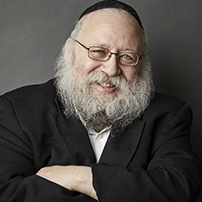
Gimmel Tammuz—the third day of the Hebrew month of Tammuz—is the day that created a barrier between the Chassidim and the Rebbe. However, ironically, our inability to physically have contact with the Rebbe has not diminished our desire to maintain our relationship with him. Indeed, the Rebbe’s “absence” has spawned so many different attempts at understanding the deep relationship that exists between the Rebbe and his followers, and indeed, the entire Jewish nation.
In this issue we will attempt to capture one pivotal aspect of the Rebbe’s connection to us that continues to reverberate and resonate with us.
To the “outside” world, the Rebbe is seen as the Jewish leader who sent thousands of dedicated young men and women to all parts of the world, including some far-flung and even dangerous locations, for the express purpose of bringing the light of Torah and Mitzvot permeated with Chassidic soul. The Rebbe’s message of Judaism permeated with light and joy was brought to the world at large indirectly through his shluchim (emissaries). And it is through these shluchim that the world was made aware of the Rebbe’s leadership and concern for every Jew and indeed for all of humanity.
No one can say how many people were affected through his indirect influence. It is likewise impossible to gauge how many lives were saved, how many people were brought back to their roots and how many grew in their Judaism as a result of the Rebbe’s outreach. One thing is clear that the number of people affected through the Rebbe’s over 3,000 emissaries—and thousands of other chassidim who do the work of the shluchim without the official title and its ripple effect—is astronomical.
What is not as well known, however, is the extent to which the Rebbe directly educated, inspired and touched the lives of people from all walks of life.
If one had to enumerate the Rebbe’s method of reaching Jews directly, one could divide it into five categories:
Farbrengens, or Chassidic gatherings, is where the Rebbe would spend hours upon hours expounding many diverse aspects of Jewish knowledge to the thousands who attended these frequent events.
Yechidus or private audiences with the Rebbe, is where the Rebbe would connect to Jews from all walks of life in a very personal way.
Distribution of Jewish items. On many occasions the Rebbe would distribute various Jewish items such as Matzah before Passover , wine after major Jewish Holidays, publications and most famously, dollar bills for tzedakah. Literally tens of thousands of people were the recipients of these items—that were always accompanied with a blessing—over the years.
Correspondence. The Rebbe communicated his ideas, counsel, blessings and guidance to thousands by way of mail and other forms of correspondence. Many of these letters have been collected in close to forty volumes thus far.
Literary output. There are many Chabad homes that possess a collection of the Rebbe’s works (most of which are transcripts of his many talks). This collection (which does not include his correspondence) contains over 200 volumes. The dissemination of these volumes and their translation and adaptations has brought the Rebbe’s voluminous and variegated teachings directly to thousands of homes and institutions of learning that helped to shape and mold the way we think.
Farbrengens.
In the course of a year, the Rebbe would gather—thirty (in early years) to about 80 times (in his later years)—with thousands of his Chassidim and others. At these gatherings the Rebbe would deliver profound discourses on a vast array of Torah subjects that included, Biblical exegesis, Talmudic analysis, intricate Kabbalistic and Chassidic thought. He would also discuss current events and issues that confronted the Jewish people from the perspective of Torah. He would also devote much time to underscore the importance of Jewish education, highlighting the unique role of women, as well as words of encouragement to all who would listen to expand the frontiers of Judaism.
Some Farbrengens lasted an hour or two and some as long as 8 hours. In between talks—as many as ten on some occasions, each dealing with a different topic—there were many personal encounters people had with the Rebbe. In addition, the people would make a L’chaim (a toast) to the Rebbe, getting very personal responses. In these Farbrengens the Rebbe would combine the deepest intellectual insights with animated singing. To thousands of people it was their most profound spiritual experience. In the later years, some of these weekday Farbrengens were broadcast on cable TV that reached tens of thousands more.
It has been estimated that over the forty plus years the Rebbe conducted these Farbrengens and other public addresses, he devoted over 10,000 hours to stimulating the minds reaching into the minds and hearts of so many.
The late Dr. Tzvi Saks of blessed memory taught at the Daemen College in Buffalo NY. The president of the College—a non-Jew—related to Dr. Saks that one night he was surfing the channels on his TV and saw the Rebbe talking. And while he admitted that he did not understand what the Rebbe was saying, the simultaneous translation notwithstanding, he was so mesmerized and inspired by what he saw, that he sat glued to the TV for the next few hours! The effect these Farbrengens had on thousands of Jews and non-Jews is inestimable!
Yechidus:
For the first twenty-five years of his leadership, the Rebbe would receive people in yechidus (“private audience”) three times a week.
The audiences, held on Sunday, Tuesday and Thursday evenings, would begin shortly after nightfall and extend through the night; some nights, the last of the several hundred visitors would depart well after daybreak. Many had only a few short minutes in the presence of the Rebbe, but all would come away with the feeling that in their time with him, however brief, the Rebbe was with them with his entire being, wholly and exclusively focused on their individual concerns.
The number of those seeking the Rebbe’s advice and blessing continued to grow; soon, all but the most urgent cases had to wait several months for a yechidus appointment.
Many would describe the yechidus as the most powerful experience in their lives.
The word yechidus signifies a private meeting. But for chassidim, the concept of a yechidus with a Rebbe has a far deeper implication. The word yechidah refers to the highest rung of the soul, the innermost core which is at one with G-d in constant and consummate unity. A yechidus with his Rebbe a one-to-one encounter between the yechidah of the chassid and the yechidah of the Rebbe charges the chassid’s yechidah with dynamism, so that it vitalizes his day-to-day conduct.
But by no means was Yechidus reserved for the Chassidim. Jews from all walks of life would come to consult with, seek a blessing and guidance from, the Rebbe. The entire spectrum of Jewish and general life was represented in the thousands of people. Again an estimate: In the course of close to thirty years that the Rebbe held these meetings, over 100,000 people were privileged to have a profound personal encounter with the Rebbe in Yechidus. These included, rabbis, prime ministers, government officials, professors, scientists and philosophers, Jewish leaders from all backgrounds and most notably “plain ordinary” Jews for whom the Rebbe’s words of comfort and inspiration changed their lives for the better. Many have pointed out that the Rebbe’s attention to the simplest of Jews was as total, unequivocal and with awesome empathy and love as it was to leaders and dignitaries! Indeed, the word “ordinary” did not exist in the Rebbe’s lexicon.
Distribution of Jewish Items
From the very beginning of the Rebbe’s leadership the Rebbe would distribute blessings (before Rosh Hashanah, wine (after each holiday), Matzah (before Passover), honey cake (before Yom Kippur and on Hoshana Rabbah) and copies of the Tanya and Chassidic discourses (at special occasions). Thousands of people would get on line (the old-fashioned meaning of the word) to receive these items from the Rebbe’s own hand.
In 1986, the Rebbe began conducting a weekly “receiving line.” Each Sunday, the Rebbe would stand in a small room near his office as thousands of men, women and children filed past to see him and receive his blessing. Many used the opportunity to pose a question and receive a word of advice. To each of them the Rebbe gave a dollar bill, appointing them as his personal agent (shaliach) to give it to the charity of their choice.
Why the dollar? The Rebbe explained his custom by quoting his father-in-law, Rabbi Yosef Yitzchak of Lubavitch, who would often say: “When two people meet, something good should result for a third.” The Rebbe wished to elevate each of the thousands of encounters of the day to something more than a meeting of two individuals; he wanted that each should involve the performance of a “mitzvah” (good deed), particularly a mitzvah that also benefits another individual.
On a given Sunday, anywhere between 5,000 and 10,000 people would receive that dollar. Frequently the Rebbe would repeat the distribution of dollars several times during the week (albeit to am much smaller crowd).
Again, a most amazing phenomenon was reported by all who came for “Sunday Dollars.” The Rebbe, well into his ninth decade at the time, would stand for as long as eight hours without interruption. Yet in the few seconds that he or she was with the Rebbe, each visitor felt that the Rebbe was there only for them. It was as though he or she were the only visitor of the day.
Once, a woman could not contain herself and burst out: “Rebbe, how do you do it? How is it that you do not tire?”
The Rebbe smiled and replied: “Every soul is a diamond. Can one grow tired of counting diamonds?”
These encounters were not just perfunctory giving of dollars and a perfunctory blessing. Rather, the people would come away uplifted and motivated to do more good. Stories of miracles and Divine inspiration occurring at these distributions are legendary.
In addition the distribution of dollars, the Rebbe would—during weekdays—distribute coins to the children on his way to the Mincha service.
Correspondence
One of the Rebbe’s direct ways of reaching people was through his prolific and prodigious correspondence. To date over 30 volumes in Hebrew have been published (containing over 11,000 letters) and about 10 volumes in English. Rabbi Sholom Ber Shapiro (the son-in-law of the legendary secretary of the Rebbe, Rabbi Dr, Nissan Mindel) related that his late father-in-law’s archives contained about 55,000 letters of the Rebbe, mostly in English! Only a “handful” have been published thus far.
When it became too cumbersome to send formal letters in response to the tens of thousands of people who wrote to the Rebbe for his sage counsel, the Rebbe would write—usually, cryptically, so only the person who wrote the letter would understand—his answer on the margin of the letter of the person who asked for his guidance. In this fashion, the Rebbe was able to guide and bless additional tens of thousands of people and relate to their most personal concerns. To this day, Chassidim study his letters for insights on a plethora of subjects and his advice and guidance for virtually every one of life’s challenges.
Excerpt from unknown person’s insight
In the file where we keep all the important family documents, there is a folder which we open from time to time. The papers in it are aging; some, indeed, are quite yellow, but we refer to it often.
There is a letter my wife received when she was a child, the response to the announcement of our engagement, some advice we received at turning points in our lives, and blessings for our children.
Our interest in the folder is more than sentimental. The answers which the Rebbe gave us in the past serve as guideposts for our present and our future. The advice that he gave us then helps us focus our energies and highlight our individual missions.
My friends have similar folders, and at times they have allowed me to read some of the letters which they received. Here, I did not have the same degree of personal interest. Nevertheless, the guidance the Rebbe gave them was always eye-opening. I enjoyed seeing how the Rebbe related to the issues they raised and the depth of insight in the answers he gave them.
On occasion, people with whom I share less close ties have shown me letters they received from the Rebbe. I remember a retailer in Manhattan where I purchased some computer equipment, an Israeli army major whom I met on a visit to the base he commanded, and a Jewish communal leader in Cleveland. It was with special feeling – something not unlike the reverence a chassid would display – that they took out the letter they had received from the Rebbe. And after reading it, I felt that I could sense why: There was a message that hit home, an insight that lifted the person above the vantage point from which he operated previously and gave him the perspective to find a solution to his difficulties.
In these situations, the setting was important. I wasn’t just reading a letter, I was seeing it in its context. That made it more alive. On the other hand, when the first volume of the Rebbe’s collected Igros Kodesh was published, the feelings I had when reading those letters was not very different. In most instances, I did not know the recipient personally. Nevertheless, the letters opened up windows through which I could observe their lives, and more significantly, see how the Rebbe’s insights enhanced their world view.
These feelings repeated themselves as each of the 24 volumes of Igros Kodesh was published. For these volumes tell us an ongoing story of the manner in which the Rebbe reaches out to people and gives them advice, compassion, and direction.
Literary output
The Rebbe did not personally write most of the books that have been published with his teachings. However, transcripts of his talks have been published and disseminated to all parts of the world, providing tens of thousands of Jews with his profound multifaceted interpretations of on a vast array of Torah subjects. The Rebbe did edit for publication over 50 volumes and another approximately 150 volumes have been published that contain transcripts of his talks and discourses. The subjects the Rebbe illuminated include: Biblical literature with particular emphasis on Rashi, Talmud, Maimonides, Kabbalah, Chassidic philosophy as well as the Jewish perspective on current events and world problems.
One unique characteristic of the Rebbe’s teachings was that no matter how abstruse and complex the subject, the Rebbe would invariably find a way of gleaning practical lessons from these teachings. To the Rebbe there was no such thing as theoretical knowledge. Every idea of Torah, according to the Rebbe’s teachings had to have an impact on our lives, and on the way we effect the lives of others.
Many of these works have been translated into several languages, and many have been condensed and adapted so that the Rebbe’s unique approach to Torah, once again, can be accessed by tens of thousands whose way of thinking continues to be shaped by these profound and inspirational teachings.
Every time we delve into or even casually read the Rebbe’s teaching we can feel the Rebbe speaking to us; stimulating our minds and opening our hearts and inspiring us to concrete action to be better Jews on all levels and thereby hasten the ultimate Redemption through Moshiach .


